Alaska Tribes Win Legal Fight Against Gold Mine
The massive Donlin Gold Mine, if built, would pose grave risks to Kuskokwim River communities.

This page was published a year ago. Find the latest on Earthjustice’s work.
Native Tribes just struck a blow to a proposal to build the world’s largest gold mine near the Kuskokwim River in Southwest Alaska, in a critical watershed that as many as 58 Tribes rely on for their existence.
Represented by Earthjustice, six Tribes challenged the mine’s permits in federal court in Alaska. On September 30, a judge ruled that the federal government broke the law when it approved the project without studying what would happen to villages downstream if a dam holding more than 500 million tons of toxic mine waste burst.
The court will decide over the next five weeks how to remedy this failure. The Tribes are asking the judge to throw out Donlin’s permit. The threat of the massive mine has loomed over these Tribes for decades, with the health of the surrounding lands, waters, wildlife, and people hanging in the balance.
A cautionary tale
On a spring day in 2023, we visited Yup’ik elder Elizabeth Andrew at Andrew’s home in the small southwest Alaska village of Tuluksak to talk about the massive Donlin Gold Mine and the grave environmental and health risks it poses to Kuskokwim River communities.
“If you want to go mining, she’ll go with you,” Angela Alexie interpreted from Yup’ik into English for Elizabeth Andrew, as the old woman’s eyes twinkled with mischief. Andrew, who is 84, steadied a hand on her walker, as if to say she was ready.
Everyone in the room laughed. The teasing felt welcoming despite the somber topic. We leaned in closer to hear what she had to say.
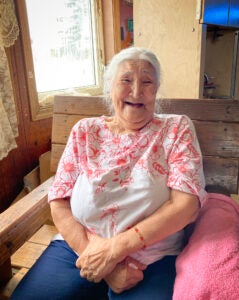
Elizabeth Andrew photographed at her home in Tuluksak, Alaska. (Elizabeth Manning / Earthjustice)
Andrew opposes Donlin and has a unique perspective to share because she once worked at another mine nearby. She has seen the destruction mining can cause and wants no more of it for her community.
When she was younger, Andrew helped with logging at the old New York-Alaska Company (Nyac) mine in the mountains near Tuluksak while her husband, who passed away from stomach cancer, dredged for gold. Mining exploration there began in the early 1900s, while gold dredging operations date back to the 1930s. Andrew doesn’t know if her husband’s cancer was due to toxic exposure from the mine but grimly notes that many people who worked there also eventually died of cancer. “They’re all gone now,” Alexie interprets for Andrew.
The Tribe’s residents believe the old mine has over time contributed to a host of environmental and health problems plaguing their village, including the river’s water, which they say is unsafe to drink; fish with discolored flesh; and high rates of cancer.
Middy Peter, former President of the Tuluksak Native Community, says Tuluksak’s experience with mining provides a cautionary tale for other Yukon- Kuskokwim region communities. What persists over generations is the environmental damage and health impacts, not the short-term financial gain that is now long forgotten, he says. “No matter how much they do to ensure safety, all mines have that danger in front of them,” Peter says.
This is not empty land
If built, Donlin would be the largest open pit pure gold mine in the world within one of the world’s largest river deltas. The ecosystem it threatens is vitally important for fish, wildlife, food security, and the physical, cultural, spiritual, and mental wellbeing of the Alaska Native people who have lived here for thousands of years.
Industry and its boosters dream of the last frontier crisscrossed with massive mines, oil fields, pipelines, roads, and other infrastructure, but it’s not empty land. Tribes who have lived in this region from time immemorial say projects like Donlin conflict with traditional ways of life and the Tribes’ present existence. Other Alaskans and Americans from across the country feel deeply about protecting these lands and waters too, as demonstrated when they raised their voices against Pebble Mine in Bristol Bay, drilling in the Arctic Refuge, and ConocoPhillips’s Willow Project — all of which Earthjustice challenged in court.
Donlin, jointly owned by two Canadian mining giants, Novagold and Barrick Gold, is supported by the region’s for-profit Alaska Native corporations, who own the surface and subsurface rights to the mine, but not by most Tribes in the region. More than a dozen Tribes have passed formal resolutions opposing the project, and six Tribes and an Alaska nonprofit, represented by Earthjustice, are challenging the project on legal grounds. All told, litigants have brought four separate lawsuits opposing the mine in state and federal court, with different plaintiffs on each case.

The village of Tuluksak sits near the confluence of the Tuluksak River (pictured) and the Kuskokwim. (Design Pics Inc / Alamy)
The wrong mine in the wrong place
The Tribes’ recent legal victory hinged on the mine developers’ proposal to build a 471-foot-tall tailings dam to contain more than 500 million tons of toxic mine waste. The court found that the risk of a catastrophic spill was a 1 in 1,000 chance in a year or 2 in 100 (2%) in 20 years. As the court stated, “to put these numbers into perspective, these same odds for the risk of an airplane crash would likely deter nearly anyone from flying,” and yet federal agencies failed to consider the risk.
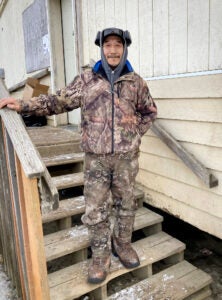
Middy Peter, former president of the Tuluksak Native Community. (Elizabeth Manning / Earthjustice)
That’s not the only problem with the Donlin proposal. Located about 10 miles north of the Kuskokwim River, Donlin would be massive in scope. Over the 27-year life of the mine, Donlin is expected to extract 556 million tons of ore to produce about 30 million ounces of gold, meanwhile generating 2.5 billion tons of waste rock, some of which would produce acid drainage. Donlin is more than the 14-square-mile mine site; it would also include a 316-mile-long buried gas pipeline from Cook Inlet in south-central Alaska to power the mine and transportation infrastructure that includes a new port, a port expansion, and a tripling of barge traffic on the Kuskokwim River, which poses both safety and environmental concerns.
The mine site includes an open pit more than two miles long, a mile wide, and 1,800 feet deep. After the mine closes, the open pit would fill with contaminated water, forming a permanent lake that would never meet water quality standards and would require water treatment in perpetuity.
“They should not be doing this,” Peter of Tuluksak says firmly. “The pit lake from the mine is going to be there forever. It’s going to be a danger to everyone’s life, every single day of our life.”
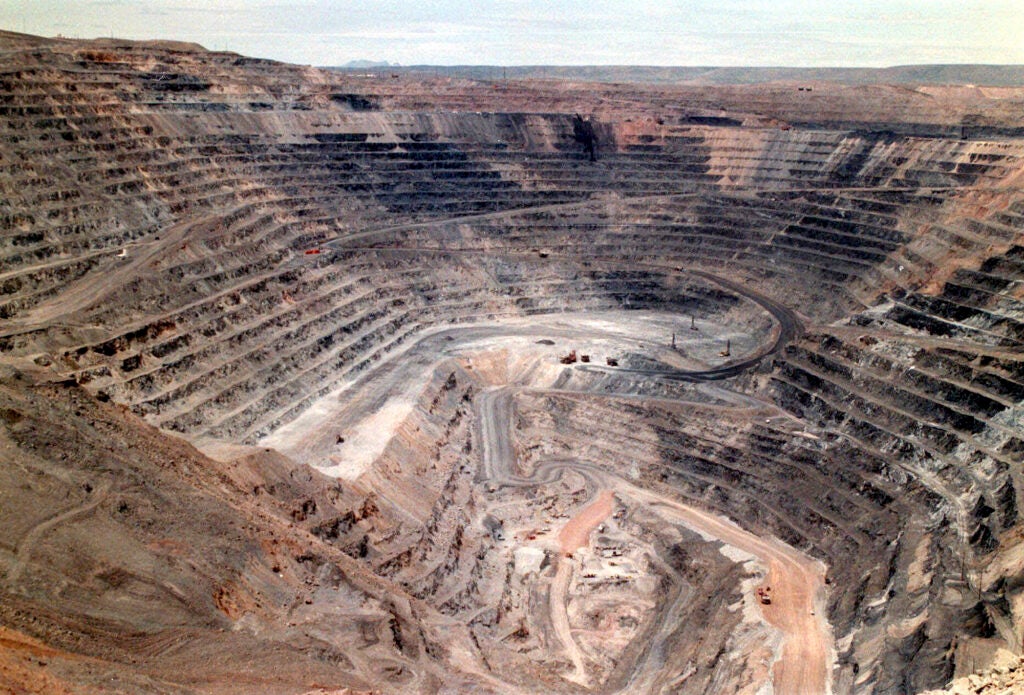
What open-pit gold mining looks like: Barrick Goldstrike Mines’ Betze-Post Pit near Carlin, Nevada, is one of the largest gold mines in the world. The open pit is so large that it is visible from space. (Adella Harding / Elko Daily Free Press via AP)
The river is their table
To understand the scope of the fight against Donlin, it’s important to understand how vital the region’s lands, waters, fish, and wildlife resources are to the Yup’ik, Cup’ik, and Athabascan people who depend on them for food and ways of life that have persisted for generations.
The Yukon-Kuskokwim Delta is one of the regions in Alaska where people are most likely to fish, hunt, or gather to provide for their families — a fact that inspires Anaan’arar Sophie Swope, a council member of the federally recognized tribe in Bethel, Orutsararmiut Native Council (ONC).
Guided by ONC leadership and elders, Swope and others last year helped form the Mother Kuskokwim Tribal Coalition, which she now leads. The coalition is bringing tribes together to help protect the Kuskokwim River, and its people and resources, from the proposed Donlin mine.
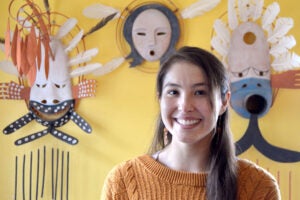
Anaan’arar Sophie Swope leads the Mother Kuskokwim coalition in Bethel, Alaska. (Courtesy photo)
Swope grew up eating traditional foods. Her grandmother teased her because she loved them so much, which brought the two closer.
“Eating traditional foods makes me feel connected to who we are as a culture,” Swope says. “I want that for future generations. When I don’t have that connection, it’s hard to navigate other things.”
In recent years, life has become more precarious in the region as Chinook and chum salmon numbers have declined and subsistence fishing has been curtailed. To be unable to fish, hunt, or gather wild foods is both devastating and frightening.
Tribal members feel a profound responsibility to protect the Kuskokwim River, which they say is their table that feeds their people.
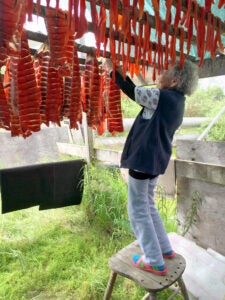
Esther Green, a Yup’ik Elder, preserves salmon in a fishing camp on the Kuskokwim River. (Diane McEachern)
The river also connects people throughout the region by providing a means of transportation between villages — by boat in the summer and on ice roads in winter when the river is frozen.
Former President Middy Peter of Tuluksak remembers when he was little, relatives would travel upriver from coastal villages along the Bering Sea to trade food items like seal oil for interior foods like moose and bear. “We feel rich when we have our subsistence foods and when we don’t have them, we feel poor,” he says.
In mid-summer, many village families head to fish camp. At these camps up and down the river, younger generations have a chance to learn from elders by watching them do things and then doing them themselves. “See, learn, do,” Swope calls it. Swope sees strong benefits in that way of learning, as well as in incorporating traditional ecological knowledge into decision-making like permitting decisions for the Donlin mine.
Growing opposition
Compared to the Pebble Mine proposal in nearby Bristol Bay, which gathered widespread opposition and was recently vetoed by the U.S. Environmental Protection Agency, the Donlin Mine project is less known. However, that’s beginning to change. More than a dozen Tribes, the Yukon- Kuskokwim Health Corporation, the Association of Village Council Presidents (AVCP), and the National Congress of American Indians have now passed formal resolutions opposing the Donlin project.
In 2018, ONC held a public demonstration in Bethel against the gold mine, becoming the first Tribe in the region to do so. The following year, AVCP, a nonprofit tribal consortium representing the interests of 56 Tribes in the Yukon-Kuskokwim region, rescinded an earlier resolution supporting the mine and passed a new resolution opposing it. According to the local media station, the opposing resolution passed with 35 delegates in favor, two opposed, and three abstaining. The vote signals that most Tribes in the region now oppose the mine.
For Beverly Hoffman, an ONC tribal member and elder in Bethel who has been an outspoken opponent of the mine for years and helped found the Mother Kuskokwim coalition, the promise of wealth distribution from the mine provides false hope to people in the region. She, Swope, and others think people are beginning to recognize that outside companies will receive most of the profit from the mine while the people who live there suffer long-term consequences.
The growing opposition to the mine gives them real hope that someday there might be sustainable economic development supported by Alaska Native Corporations and others that aligns with their region’s cultures and traditional ways of life instead of fighting against them.
For now, advocates for a healthy Kuskokwim River are celebrating the court win and waiting to hear the fate of the mine’s permit.

Boaters make their way along the Kuskokwim River near Bethel, Alaska. (Greg Lincoln / The Delta Discovery)
Originally published on July 31, 2023. This article was updated to reflect the Tribes' legal victory.
Opened in 1978, our Alaska regional office works to safeguard public lands, waters, and wildlife from destructive oil and gas drilling, mining, and logging, and to protect the region's marine and coastal ecosystems.